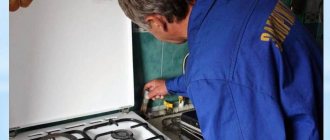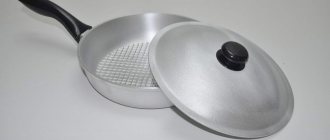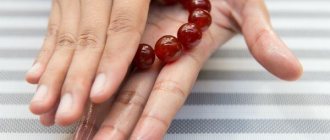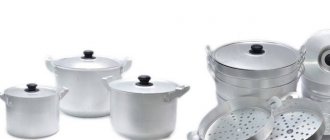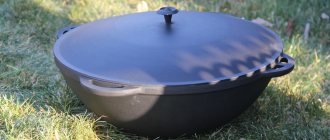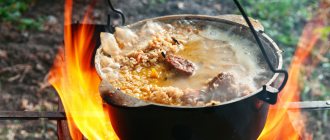Kitchen items made from aluminum alloy have a number of positive qualities. Thanks to them, they are popular with buyers. In order for a new aluminum frying pan to serve as long as possible and not lose its beautiful appearance, it must be properly prepared for use. There are various calcination techniques suitable for aluminum cookware. When performing the procedure yourself, remember the basic safety rules.
Features of aluminum and duralumin frying pans
It is customary to distinguish 3 technologies for the production of aluminum cookware:
- Stamped. This method is the cheapest and involves making a frying pan by cutting and stamping a finished aluminum sheet. As a result, the walls of the dishes are thin and excessively flexible. They are easily damaged and deformed, their service life is no more than 3 years.
- Forged. Forged aluminum products are quite durable. They are produced by pressing metal using a special apparatus. The bottom of the cookware is often equipped with steel plates.
- Cast. Making a cast aluminum frying pan is an expensive process that involves pouring molten material into molds of a specific configuration. During the production process, the metal retains its beneficial qualities. Cast cookware is characterized by durability and the ability to heat evenly.
Aluminum kitchen items are made of aluminum with an admixture of other metals: copper, magnesium, iron and silicon.
About the dangers and benefits of an aluminum frying pan
Aluminum and aluminum frying pans have the following advantages:
- low cost;
- light weight of products;
- uniform heating;
- cast aluminum does not corrode;
- possibility of preparing dishes without adding oil;
- harmlessness to human health;
- easy cleaning process.
The main disadvantages of aluminum frying pans:
- high probability of deformation under mechanical stress;
- Cookware made of duralumin without a non-stick coating may rust;
- the aluminum surface can be easily scratched with a sharp object;
- any damage to the coating negatively affects the quality of the food;
- Excessive heat causes food to stick;
- susceptibility to oxidation.
What can you cook?
It is inappropriate to talk about categorical prohibitions on the use of aluminum pans. But it is better not to cook individual dishes in it, which can ruin the appearance and shorten the shelf life.
Do not cook acidic or alkaline foods in aluminum pans, such as sour cabbage soup, compotes, sauces, marinades, vegetables: potatoes, beets; baby and dietary food. The acid and alkali contained in such products destroy the protective oxide layer, resulting in aluminum oxide in the form of a dark coating. Aluminum hydroxide may form, which is toxic.
You cannot collect sour berries in such a container, for example, cranberries. Since it contains a lot of acid, and it destroys the protective film, the metal comes into contact with the product and enriches it with itself. A high concentration of aluminum in berries is harmful to the body.
Aluminum pans are considered indispensable when preparing side dishes from cereals, pasta, and potatoes. These dishes do not burn and do not damage the dishes.
Is it possible to make jam?
There is no clear answer. When cooking preserves, jams, marmalade, the berries are covered with granulated sugar until the juice appears. It releases acid, which is known to destroy the protective film of an aluminum pan, and the metal comes into contact with the product. The jam is cooked in 2 or even 3 steps. It turns out that the product comes into contact with aluminum for a long time, and the jam absorbs the metal. Therefore, it is better not to use an aluminum pan for making jam. If this concerns five-minute jam, then you can cook it and immediately transfer it to jars. But, if you cook it several times, it is advisable not to use aluminum cookware.
Read also: Mudras for protection from enemies and negativity
How to prepare a new aluminum frying pan for the first use?
A new uncoated cast aluminum frying pan requires proper preparation for use. After purchasing, rinse it thoroughly with warm water with the addition of a gel or liquid soap. This will help remove industrial dust and dirt. To completely remove technical oil and harmful particles from the inner surface, boil water in a container for half an hour.
Some housewives do not know what to do when aluminum utensils burn. To avoid burning of food, the dishes need to be heated several times.
Calcination with salt
Pour large salt crystals into a dry frying pan so that they completely cover the bottom. Place the container on the fire and leave for 10-20 minutes. Then turn off the stove, wait until the dishes cool down, and remove salt from its surface. Soak a soft sponge or cloth with vegetable oil and treat the inside. Before use you need to wait 2-3 days.
Calcination with vegetable oil
You need to pour refined sunflower oil into the container. Place it on low heat and heat for half an hour. Then remove the pan from the stove, and after cooling, rinse with warm running water without using cleaning agents. Do not use for 1-2 days.
Combined method
The combined method involves 2 stages of calcination: the first - using salt, the second - with the addition of vegetable oil. To save time, the procedure can be carried out in 1 stage, adding 1 tbsp before heating. salt crystals into the oily liquid. Heating should continue for 20-30 minutes, then leave the container on the table until it cools completely.
Simplified method
A simplified calcination method involves placing a dish greased on both sides with sunflower oil in a preheated oven for 1 hour. After this time, turn off the household appliance and leave the pan in it until it cools completely. You can use the product after 2-3 days.
Method 3. Oven
A cast iron frying pan can be heated equally well both on the stove and in the oven. This method is the easiest: you just need to grease the dishes with oil and let them simmer for 1-2 hours. Rules for calcining a cast iron frying pan in the oven:
- Clean the dishes with detergent, rinse and dry with a towel.
- Lubricate the entire inner surface with vegetable oil. Blot off excess. To be sure, wait a few minutes and blot again.
- Place upside down in preheated oven. Oven temperature - 180 degrees.
- Line the bottom of the oven with baking paper or foil. It will collect the flowing oil.
- Wait an hour or two, then take it out. Some housewives calcinate cast iron for three hours.
- Let the pan cool completely, then re-coat the bottom with vegetable oil.
Important safety rules when calcining an aluminum frying pan
To avoid injury and burns, carefully follow the safety rules during calcination:
- Remove the product from the heat using thick oven mitts or oven mittens. Then place it on a special stand, and not on the table surface.
- Do not add water to heated oil.
- Do not wash a hot pan. Give it time to cool a little and only then start cleaning.
- Remove flammable objects from the stove.
- Turn on the hood to maximum mode and open the window.
- Do not exceed the incandescent temperature allowed in the instructions.
In what other cases is it necessary to calcinate
Calcination is required not only for a new frying pan, but also for the sake of prevention and even getting rid of problems that have appeared on old ones.
- Cast iron frying pans often form carbon deposits - burnt oil. This is harmful to health, so you should not cook on such a surface. In this case, calcination will help, since it can destroy the accumulated carbon deposits, after which it will be easy to wash. Usually the question of how to properly burn a frying pan from soot is asked before cooking pancakes. This way the pan is cleared of old oil - even the first pancake will not be lumpy.
- If cast iron cookware begins to rust, then it must be properly treated to remove rust. First of all, it is necessary to clean the damaged areas. This can be done with a special product or a simple cleaning powder. After this, they are additionally sanded with fine-grain sandpaper. The cookware can then be baked to create a new protective coating to prevent future rust.
Cleaning an aluminum frying pan from soot and burnt food
Over time, a layer of burnt food residue or soot appears on the aluminum. Firstly, it is not aesthetically pleasing, and secondly, it is dangerous to health. And it is advisable to periodically clean the old frying pan from dirt.
This is easy to do at home. The methods are not expensive, because everything you need is usually available.
Here are some important points to consider:
- Aluminum cookware does not like the use of harsh abrasives and alkalis. Because of them, the oxide film may be damaged and food will begin to stick to the surface;
- choose only soft sponges and cloths;
- Wash such utensils only by hand; they may become deformed in the dishwasher.
Boiling or boiling
A gentle and at the same time reliable way to deal with old carbon deposits on any frying pan or saucepan. And at the same time the outer and inner walls will be cleaned. You need to prepare a container that will hold dirty items. Prepare the mixture. We offer two options:
- A teaspoon of salt + the peel of one sour apple + half an onion (consumption per liter of water);
- Soda ash 500 g + stationery glue 200 g + a piece of laundry soap (consumption per 10 liters of water)
You need to boil for about two hours. Then wait for it to cool completely and wash with warm water.
If you only need to clean the inside of the pan:
- Fill the container with kefir to the brim. Leave for 2-3 hours. Rinse.
- Grate a small piece of laundry soap and add a tablespoon of ammonia. Dilute with warm water and pour the liquid into a bowl. Leave for 6-8 hours. Then boil and rinse.
- Fill the pan with water. Add 1 tbsp. spoon of soda, salt and citric acid. Boil for 30 minutes. Rinse it off.
Removing light carbon deposits and adding shine
Vinegar or citric acid are suitable for this. You can use a slice of lemon. Wipe the darkened stain with a cloth with the composition applied to it. Stationery (silicate) glue copes well with stains. Apply it to the surface using a swab. After that, rinse with warm water. Such methods will not only make the surface clean, but also restore its shine.
Using household chemicals to combat carbon deposits
Hardware stores and chain companies offer a variety of cleaning products.
The eco-product “Special Paste” will perfectly cope with old stains, while adding shine. “Mister Muscle”, “Shumanit”, “Frosch” help to remove dirt well. After using them, a pleasant fresh aroma will remain in the kitchen.
Errors when cleaning
| Error | Consequences |
| Bulk products | Abrasive preparations severely scratch the protective layer. Dishes in the frying pan burn. |
| Wire brush | The same problem - the non-stick layer is destroyed. A brush can be used, but only with soft bristles (for clothes). |
| Calcination or boiling for too long | If during these procedures the frying pan is left on the fire for more than 1 hour, then it will be more susceptible to the appearance of new soot. |
| Aggressive chemistry | Aggressive agents (plumbing, etc.) “corrode” the coating layer. Therefore, you need to use only kitchen chemicals, they are more gentle. |
Descaling
Scale is the deposit of magnesium and calcium salts due to the use of hard water. It can be easily dealt with with acid. But, since aluminum does not like aggressive influences, we will use mild means. Here are some ways to remove scale:
- Pour one spoon of soda ash, add a glass of water, and boil. Cool. Repeat boiling 2-3 times. Usually, the scale comes off on its own. If that doesn't work, scrub a little with a sponge.
- Boil water in a container, add one tablespoon of soda and leave to cool. The scale will soften and can be easily removed with a soft cloth.
- Pour Sprite or Cola into a bowl and bring to a boil. Leave to cool, then rinse. The same can be done with cucumber pickle.
Our grandmothers used aluminum frying pans, but even today they remain a favorite utensil. They are light and comfortable. Do not require complex care. Durable. If you occasionally clean them of old stains, they will serve your grandchildren.
Consolidating the effect obtained
The best way to protect an aluminum frying pan from burning for a long time is to repeat the calcination several times.
.
- wash the frying pan with soft sponges and do not use hard, abrasive or metal products;
- Stir and turn food with a wooden or plastic spatula;
- If, over time, burnt particles appear, then sprinkle them with baking soda and rub lightly - the dirt will be easily removed.
Remember that it is better to do a simple preliminary preparation before use immediately after purchasing an aluminum frying pan and not to put it off until later, when you will need it for cooking.
If you don't want to bother with preparation, buy frying pans with. Find out how to choose or in other instructions on our “Types of Cookware” website.
Manufacturers of frying pans offer us many types of frying pans: with diamond, ceramic or Teflon coating, made of aluminum, steel and other materials. But not everyone likes new cookware; many return to old frying pans and cast iron pots. And if there is no such thing left from your relatives, then you buy cast iron cookware yourself. But after purchase it is worth calcining the utensils.

